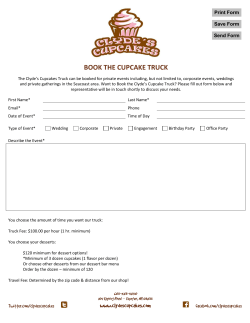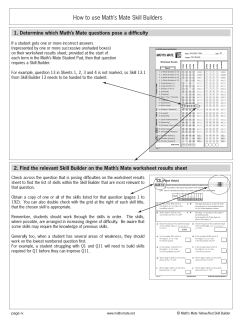
Eureka Math Parent Guide (2nd Grade)
Eureka Math Parent Guide A GUIDE TO SUPPORT PARENTS AS THEY WORK WITH THEIR STUDENTS IN MATH. GRADE 2 MODULE 3 GRADE FOCUS TOPIC OVERVIEW Second Grade mathematics is about (1) extending students’ understanding of base-ten notation; (2) building fluency with addition and subtraction; (3) using standard units of measure; and (4) describing and analyzing shapes. Topics are the lessons within a module that help children master the skills above. Here are the lessons that will guide your child through Module 3: • Module 1: Sums and Differences to 20 • Module 2: Addition and Subtraction of Length Units • Topic B: Understanding Place Value Units of One, Ten, and a Hundred » Module 3: Place Value, Counting, and Comparison of Numbers to 1000 • Topic C: Three-Digit Numbers in Unit, Standard, Expanded, and Word Forms • Module 4: Addition and Subtraction Within 200 with Word Problems to 100 • Topic D: Modeling Base Ten Numbers Within 1,000 with Money • Module 5: Addition and Subtraction Within 1000 with Word Problems to 100 • Topic E: Modeling Numbers Within 1,000 with Place Value Disks • Module 6: Foundations of Multiplication and Division • Topic F: Comparing Two Three-Digit Numbers • Module 7: Problem Solving with Length, Money, and Data Module 8: Time, Shapes, and Fractions as Equal Parts of Shapes • Topic G: Finding 1, 10, and 100 More or Less Than a Number LET’S CHECK IT OUT! MODULE 3 FOCUS In Module 3, students expand their skill with and understanding of units by bundling ones, tens, and hundreds up to a thousand with straws. MORE SPECIFICALLY, CHILDREN WILL LEARN HOW TO: • Understand that the three digits of a three-digit number represent amounts of hundreds, tens, and ones; e.g., 706 equals 7 hundreds, 0 tens, and 6 ones. Understand the following as special cases: • Topic A: Forming Base Ten Units of Ten, a Hundred, and a Thousand WORDS TO KNOW • Base ten numerals: e.g., a thousand is 10 hundreds, a hundred is 10 tens, starting in Grade 3 a one is 10 tenths, etc. • Expanded form: e.g., 500 + 70 + 6 • Hundreds place: e.g., the 5 in 576 is in the hundreds place • One thousand: 1,000 • Place value or number disk: pictured • Standard form: e.g., 576 • Unit form: e.g., 5 hundreds 7 tens 6 ones • Word form: e.g., five hundred seventy-six » 100 can be thought of as a bundle of ten tens – called a “hundred.” » The numbers 100, 200, 300, 400, 500, 600, 700, 800, 900 refer to one, two, three, four, five, six, seven, eight, or nine hundreds (and 0 tens and 0 ones). • Count within 1000; skip-count by 5s1, 10s and 100s. • Read and write numbers to 1000 using base-ten numerals, number names, and expanded form. • Compare two three-digit numbers based on meanings of the hundreds, tens, and ones digits, using >, =, and < symbols to record the results of comparisons. Unit form modeled with place value disks: 7 hundreds 2 tens 6 ones = 72 tens 6 ones SAMPLE PROBLEMS SAMPLE 1 What is a bundle? Bundling is also called grouping. This is a way to group numbers by putting the smaller units together to make a larger one. For instance, putting 10 ones together makes 1 ten. Putting 10 tens together makes 1 hundred. This method helps students understand place value, which is a foundational concept for all of mathematics. Bundles of 100 Bundles of 10 Ones What is the total number of sticks? SAMPLE 2: Subtraction Word Problems Tammy and her mom sold 70 cupcakes at the bake sale. If they baked 100 cupcakes, how many cupcakes do they have left? One way to sove this problem is by drawing circles that represent 10. Mark off the 70 cupcakes that were sold. How many cupcakes are left? Another way is to draw a tape diagram. Start by drawing a box to represent 100 cupcakes. Next draw the box to represent 70. Mark the unknown amount with a question mark. How many more cupcakes are needed to get from 70 to 100? HOW YOU CAN HELP AT HOME • Skip count when counting groups of nickels and dimes. • Count in a pattern while doing a rhythmic or repeated task – stirring pancake batter, brushing hair, putting away groceries, walking. • Roll two dice to make a two digit number. Subtract it from 99 or 100. • Represent two digit numbers with popsicle sticks – make bundles of ten for the tens and use single sticks for the ones. • Roll dice to make two or three digit numbers with a partner. See who can make the larger number. • Find or roll numbers and tell which place value each digit represents.
© Copyright 2025
















